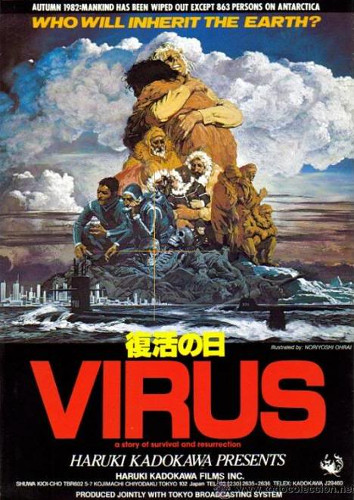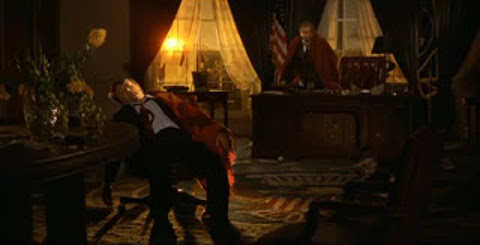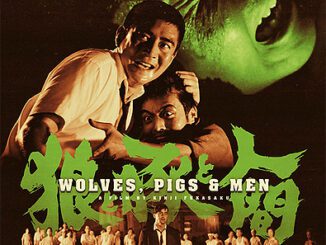Virus (1980)
Directed by: Kinji Fukasaku
Written by: Gregory Knapp, Kinji Fukasaku, Koji Takada, Sakyo Komatsu
Starring: George Kennedy, Masao Kusakari, Olivia Hussey, Robert Vaughn
AKA FUKKATSU NO HAI, DAY OF RESURRECTION
JAPAN
AVAILABLE ON DVD
RUNNING TIME: 155 mins, 108 mins [export version], 94 mins [US TV version]
REVIEWED BY: Dr Lenera
American geneticist Dr. Meyer accidentally creates a deadly virus named MM88 which is then developed in secret by the hawkish General Garland. A plane crash accidentally releases it, and MM88 proceeds to kill off nearly all of the world’s population. However, the virus is inactive at temperatures below -10 degrees Celsius, and the polar winter has spared the 855 men and eight women stationed in Antarctica where scientists desperately try to find a cure. However, before his death, Garland did something very dangerous which, combined with the possibility of a forthcoming natural disaster, could well and truly spell the end of humanity….
With the state of virtually the entire world right now, one’s mind, if you’re a film obsessive, can’t help but turn to thoughts of movies about viruses and the end of the world as we know it. Some of us weirdos even find watching this stuff oddly comforting [TV’s recent showing of Contagion was controversial but got high ratings], though of course I respect the decision of any of our readers who decide not to click on to this review. But a few weeks ago me and a few others were chatting about such films on a discussion forum, and somebody brought up this particular example, which covers both bases, being an end of the world movie that also features the most deadly of all viruses. I remembered that I used to own it on video way back when, and fond [possibly an inappropriate word] memories of certain scenes and images flooded back to me, even though I’d never replaced my copy with a DVD version. I didn’t even know until this chat that the version I once owned was shortened by half an hour from its original Japanese version, though I do recall it being a bit choppy. So I set out to watch the original cut, and luckily due to being in the public domain it can be viewed for free on Youtube [though be warned that it may take you a while to find an English subtitled print], while DVDs are really, really, cheap. The first thing I should emphasise it that it does indeed contain imagery and situations which are very close to what’s going on right now, and therefore may upset many. But, setting that aside for now, how does it fare just as a film for us morbid types who feel compelled to watch movies like this at the moment? Well, it attempts to be epic and partly succeeds, aided by its mostly sober approach that sets it aside from many of the other entries in the ‘70s disaster movie cycle. At times it’s genuinely thought provoking, genuinely haunting, and genuinely scary. Saying that, it does suffer from some awkward story telling and a few odd moments that don’t work.
In the 1970s, producer Haruki Kadokawa formed the Kadokawa Production Company, its main intention to develop films that were often based on literary properties held by Kadokawa’s publishing arm, and sometimes with American cast members such as George Kennedy to boost overseas potential. The domestic box-office for these films was large, which led to Kadokawa putting two million yen into Virus, making it the most expensive film in Japanese history on its release. Based on the novel Fukkatsu no hi by Sakyo Komatsu, it was originally going to be directed by John Frankenheimer until he bailed out. The production still employed the services of several American ‘stars’, and was shot in Tokyo, Machu Picchu in Peru, and various locations throughout Canada, including Kleinburg, Ottawa, and Halifax. The production was heavily supported by the Chilean Navy, who lent a submarine for use as a filming location. During filming, a Swedish cruiser used to transport crew was heavily damaged by a coral reef off the Chilean coast, and had to be rescued by the Navy. An IMDB review of the film by ‘Media-576-216640’ who acted in it makes these reminisces about some of the cast members: “Chuck Connors: quipped between takes: “Not bad for fourteen grand a day.” Bo Svenson: He carried a whoopie cushion and sidled up to people, making fart sounds, which he thought was hilarious. He also took a lot of pride in showing us his underwater demolition license. George Kennedy: Self-absorbed, sullen and forbidding, spoke with no one. Edward J. Olmos: Nice guy, friendly, engaging. Cec Linder: Liked to play poker between scenes. A very elegant gentleman, exuded mentshlekhkayt. Olivia Hussey: Stayed in her dressing room most of the time, listening to Bob Dylan on a cassette-player”. Virus flopped in Japan and went straight to video or TV elsewhere.
I usually do a brief comparison of the different versions of a film before I go into the main part of a review, but I thought that with this one it might be easier to refer to the major changes as I go along with what is principally a write-up of the Japanese cut which is, of course, the one to see. The American cut begins with a shot taken from near the end of the film of Shûzô Yoshizumi, the main protagonist in the Japanese cut but not so much the American, walking against a setting sun before rewinding to detail how MM88 got loose. However, the Japanese opens in a superior fashion with a scene that takes place much later in the American, of a submarine nearing a desolate, corpse-laden Tokyo, before going back in time to reveal how we got here, and of a guy, Yoshizumi haunted by the fact that he left his pregnant girlfriend Noriko to go on this mission to Antarctica. Then we get some cold war intrigue, with the US and Germany fighting over this super virus. America made it, but Germany stole it. America gets it back but the plane containing the virus crashes, resulting in Garland ensuring that Meyer, MM88’s creator, gets carted off to an asylum, but when the virus is released by mistake with horrible consequences little else seems to matter. We see people passing out in public places, hospitals overflowing, piles of corpses being burned with a flame- thrower, and a truly devastating montage showing the appalling death rate in some of the world’s major cities – I don’t need to go into how frightening and real it all seems yet the film doesn’t really sensationalise this stuff – it’s brief and to the point with far more time [perhaps too much for some] spent elsewhere.
Flashbacks show Yoshizumi to be truly guilt ridden, and cutting so much of the character from the American version was a big mistake because in that cut he then suddenly becomes a major character in the second half while in the Japanese version he’s to the forefront in the first half too. We also spend some time with the American president and co, with Glenn Ford certainly not acting like he’s slumming it while Henry Silva is typically hammy as Garland who is convinced that MM88 eminates from Russia. A really poignant scene featuring Ford and Robert Vaughn as Senator Barkley may be also notable for featuring the best-looking shot of the film as the two basically say their farewells to each other while the sun rises outside the window, in a film rather devoid of this kind of stuff – in fact director Kinji Fukasaku [Battles Without Honour And Humanity, Battle Royale] seems overcome at times by the scope of what was a two-year shoot so his film looks a tad TV-ish at times. Around half way through things contract somewhat as civilisation is basically limited to a couple of submarines – one Soviet and one British – and Antarctica where 855 men and eight women now reside. A rape attempt results in the decision being made for the women to sleep with many of the men in order to continue the human race. There’s a cruel logic about this, though it’s a bit silly that everyone agrees with this, and with only two year’s supply of food surely all this reproduction is pointless? – but maybe that’s the point. I’m not sure that Olivia Hussey, as Marit, who’s found in a shack-full of dead bodies, has ever been more beautiful. She’s supposed to be Norwegian, but that’s not anywhere near as silly as Chuck Connors turning up as a British submarine captain called Captain McCloud and making no attempt at an accent whatsoever. A few unintentionally goofy moments do intrude – I can’t seem to get the line “you’ve gone and given me a god damn placebo” out of my head – though some of them are probably the result of a Japanese director who spoke no English directing American actors.
This film was released on DVD in North America as part of a set called ‘The Sony Chiba Action Pack’, but Chiba’s hardly in it. It’s actually Bo Svenson who ends up sharing hero duties with Yoshizumi as the two set off on a mission to stop something just as terrible as what’s already happened. Yes, this movie gives you a catastrophic, world-wide disaster, then threatens you with another disaster which is almost as plausible, before giving us a trek which is decidedly less plausible yet still rather powerful in a way, driven by love more than anything else. It’s just a slight shame that Masao Kusakari doesn’t quite do the part of Yoshizumi justice; he’s decent, but not much more than that, and moments like his ‘chat’ with a group of skeletons in a church tend to hit hard for other reasons. In some ways Virus is quite subtle despite its subject, with not much use of special effects for a start [one important sequence could certainly have been helped by some instead of some obvious and even familiar stock footage], though we do get lots of shots of rather convincing dessicated corpses. Perhaps the most heart-rending sequence, which was totally absent from the American cut and which really got to me, is when the folk in Antarctica receive a message on the radio from a boy who says he’s five and that his dad is lying down and won’t get up – and yet the boy remains just a voice, you don’t see him. I can’t decide as to whether scenes such as a meeting of the international heads in Antarctica [James Bond fans look out for the worst Felix Leiter Cec Linder doing much better even if in a very small part] degenerating very quickly into melodramatics and actual violence are a good thing in controlling the devastating sadness of much of this movie, even if they were not intended to fulfill that role – or maybe I’m just being unusually but appropriately sensitive. Normally I love it when a film goes as dark and upsetting as possible.
In the end Virus can’t help but compel, but is undeniably a tad unwieldy. It would have made a superb mini-series, in fact I wouldn’t object to it being remade as one, as it often feels rather compressed as a film even if its overall pacing is of the leisurely kind [yes I know that this doesn’t make sense but it will if you watch it]. One thing which doesn’t help much is the music, which mostly consists of the instrumental backing to the title song ‘Toujours Gai Mon Gher’ [‘You Are Love’] which is as sappy and as bland as they come, ye its lyrics do kind of relate to the emotion of the film even if I wonder how much say, Jerry Goldsmith, would have musically enhanced the proceedings. But I do feel that Virus has been rather overlooked and maybe its time will come. It finishes with a romantic reunion that initially struck me as being condescendingly cheesy. But once I’d thought about it I realised that the prime intention was to leave us with a moving portrait of the human race struggling to prevail against all odds even if such odds are really rather futile – so in the end this on-the-surface highly depressing movie is just a bit uplifting and not in a way that does disservice whatsoever to its subject. Which seems about right to be honest.










Hi thanks for your review of Virus. Do you know where the ‘church’ scene at the end was filmed, with the subtitled corpses conversation was ? It has haunted me for years, wonder if that church still stands? Thanks Matthew
Hi Matthew
Thankyou for your comment. No, I don’t know where that church is sorry, there is some rough information about the film’s locations but not a lot of detail. This flawed but often very powerful and haunting disaster epic really deserves a decent release on disc with a audio commentary.
The church at Tiobamba is an old Spanish colonial church located in the Sacred Valley of Peru, near the town of Maras.